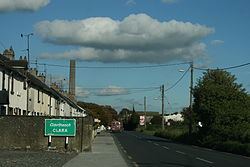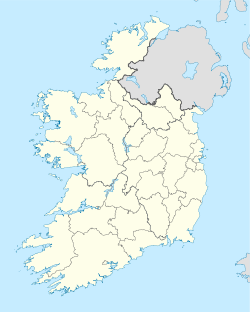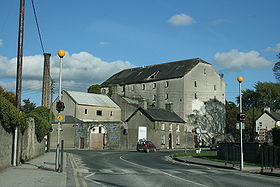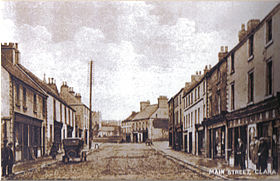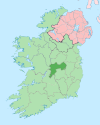- Clara
-
Clara
Clóirtheach— Town — Clara on the R436 Location in Ireland Coordinates: 53°20′34″N 7°36′49″W / 53.342661°N 7.613525°WCoordinates: 53°20′34″N 7°36′49″W / 53.342661°N 7.613525°W Country Ireland Province Leinster County County Offaly Elevation 57 m (187 ft) Population (2006) 3,001 Irish Grid Reference N254325 Historical populations Year Pop. ±% 1821 1,174 — 1831 1,149 −2.1% 1841 1,357 +18.1% 1851 996 −26.6% 1861 915 −8.1% 1871 832 −9.1% 1881 956 +14.9% 1891 1,092 +14.2% 1901 1,111 +1.7% 1911 1,096 −1.4% 1926 1,726 +57.5% 1936 1,590 −7.9% 1946 1,635 +2.8% 1951 1,684 +3.0% 1956 2,628 +56.1% 1961 2,477 −5.7% 1966 2,424 −2.1% 1971 2,156 −11.1% 1981 2,596 +20.4% 1986 2,736 +5.4% 1991 2,505 −8.4% 1996 2,464 −1.6% 2002 2,704 +9.7% 2006 3,001 +11.0% [1][2][3][4][5] Clara (Clóirtheach or An Clárach in Irish) is a town on the River Brosna in County Offaly and is the 10th largest town in the midlands of Ireland. The town has a population of 3001 (2006 census), however a number of well populated housing estates lie outside the town boundary making the actual population higher. Clara has plenty of local services including churches, banks, credit union, schools, supermarkets, shops, garages, pubs, nightclubs and restaurants. It has its own Garda(police) and fire station while the Midlands regional hospital is located just seven miles away in Tullamore. Clara has a strong association with sport. The successful GAA club looks after Gaelic football and hurling from under 8 to senior level. Clara also has a successful junior soccer club. The town has two swimming pools and a successful pitch and putt club. Clara's power lifting club has won a number of national and international awards. A golf driving range is located in the town also with the Esker Hills golf club located just outside the town. There is a local equestrian centre and sports centre also.
Contents
Geography
Clara is situated in the north of County Offaly near the border with County Westmeath, on national route N80 some 12 km northwest of Tullamore. Situated on a plain (Clóirtheach meaning plain or level place), the town is in reality an urban centre surrounded by a series of mini-villages. The town is connected to the River Shannon by one of its tributaries, the Brosna. Clara is the modern name of what was known as the Barony of Kilcoursey and Parish of Kilbride. The earliest known map of Clara dates from the Ordnance Survey of 1838.
History
While the town as we know it today was established by Quakers in the mid-18th century, there is evidence of community habitation for some time. Situated on the Esker Riada, the ancient thoroughfare which connected the east and west coasts of Ireland, numerous ring forts are to be found in the countryside surrounding the town suggesting that the early settlement may have been an important staging post for travellers. Just outside the town in Kilbride, the remnants of a 12th century monastery testify to the existence of a vibrant religious presence. According to tradition this monastery was founded by St Brigid of Kildare (d.c 525 AD) and is linked by an ancient road to Durrow Abbey founded by St Colm Cille (St Columba). St Brigid's original monastery, founded shortly after her religious profession - her first foundation, would have been constructed in wood and consisted of a number of buildings surrounding a central church. These buildings were replaced by stone structures in the 12th century. The original parish was named after St Brigid: Kilbride (from Cill Bhride: the Church of Brigid). The ruins of an ancient church are to be found not far from the monastery at the foot of a hill (Chapel Hill) and this may have been the original parish church.
Politically the family which had dominion over the area was the Sinnach O'Catharniagh (Fox O'Carney) clan; they were referred to as the Muinter Tadgain (people of Tadgain). The O'Catharniagh were princes of Teffia (an area in County Westmeath). The ruins of their castle, Lehinch Castle, are to be found on a hill in Kilcoursey, less than a mile from the town centre. The McAuley family are also associated with the Barony of Kilcoursey. Mass rocks are also to be found in the hills outside the town, having provided secret places for Catholics to worship during the persecution which followed the Reformation.
The Fox family owned much of the district up until the 1650s. Following the involvement of the Chieftain, Hubert Fox in a rebellion in the 1640s - he was defending Catholic interests against the Puritan Oliver Cromwell who came to Ireland to suppress uprisings against English rule. Ironically, in 1599, Fox's father, also Hubert, had signed an agreement of "surrender and regrant" with the English crown to avoid the complete destruction of his estates following the Nine Years War: the lands were returned to Fox senior in recognition of his fealty. Hubert junior, however, was not so inclined, preferring to stand by the family's traditional allegiance. Cromwell proved victorious and Fox lost his lands which were given to Samuel Rust, a Cromwellian soldier. He in turn sold the district to two families - the Armstrongs and the Bagots. The Armstrongs settled in the town and would eventually establish industries, notably a Linen factory which proved quite lucrative. Andrew Armstrong (1727–1802) built Clara House on the west side of the town in the 1770s - a fine neo-classical building. Members of the Armstrong family distinguished themselves in other areas of life. One of them, John Armstrong, uncle of Andrew, was Governor of Minorca and author of a history of the island in 1752. Andrew Armstrong died in 1802 and the estates were sold to a Cox family, another family with notable connections.
In 1825, the Goodbody family moved to Clara from Mountmellick and introduced industry into the town, trading under the name of J & L F Goodbody. Buying flour mills at Erry and Charlestown, they developed the river Brosna and used it to harness power for their factories. In 1864 the Goodbodys started a jute factory at Clashawaun. The jute was imported from India and the resulting bags were exported worldwide. In the last decades of the 20th century the factories declined and the last Goodbody's factory closed in 1984. The family had provided the people of Clara with employment in a number of areas: factory work, domestic service and farming. Other industries in the town included flour mills, distilleries, a brewery, manufacturers of tobacco, soap, candles, and clothes together with food processing companies.
As the town entered a heyday at the end of the 19th and for much of the 20th centuries, its prosperity led to a number of building projects. Stately houses litter the town and surrounding countryside as the various members of the Goodbody family set up their households. Thanks to Catholic Emancipation in 1829 a more prominent Catholic church was built on the outskirts of the town in Charlestown, but this proved too small and in the 1880s the parish, now St Brigid's Parish, built a fine neo-gothic church in the centre of the town on one side of the main square: a relic of St Brigid is preserved in the church. To cater for the needs of the townspeople, two religious orders founded communities and schools: the Franciscan Brothers arrived in 1821 and the Sisters of Mercy some years later. Other religious buildings in the town consist of St Brigid's parish church for the Church of Ireland community (Anglican Communion) looking down over the Fair Green and the Friends' Meeting Hall (Quaker) which is no longer in use. As the town prospered so did social life. Numerous cultural and sporting associations flourished in the town and continue to do so to this day.
Transport
Clara railway station opened on 3 October 1859, and located beside Railway View Housing Estate.[6] It is on the main Dublin to Ballina / Westport / Galway railway line. Clara was once a railway junction, with a branch to Streamstown on the now disused Athlone–Mullingar link. There was also a railway junction west of Clara serving the Banagher branch line. Clara is also served by the M6 Dublin/Galway motorway with junction 6 less than 5 minutes drive from the town centre. Consultation is ongoing regarding a small airport which is proposed on lands between Clara, Tubber and Horseleap.
Notable figures
St Brigid of Ireland (c 450 – c 525). Also known as St Brigid of Kildare. Born in Faughart, Co. Louth, Ireland, St Brigid was the daughter of a pagan chieftain and Christian slave woman. She was religious by nature and when she reached maturity she took vows under St. Mel. She founded a famous monastery in Kildare (Cill Dara) which became an ecclesiastical city and eventually the cathedral city of a diocese. She was revered as a saint in her own lifetime. She is buried with St Patrick and St Columba in Downpatrick, Northern Ireland: the three are considered the patron saints of Ireland. Her association with Clara is ancient: according to tradition she founded her first monastery there, the ruins of which are still extant. She is the patron of the parish of Clara and the local Catholic church preserves a first-class relic of the saint.
Matilda de Lacy (1223–1289). Born in Lincolnshire in England in 1223, Matilda (Maud) was one of the most significant women of her time. The daughter of John de Lacy, the Earl of Lincolnshire and Margaret de Quincy, Countess of Derby, granddaughter of Walter de Lacy, Lord of Meath, she inherited a considerable fortune following her grandfather's death on 1241. As the eldest of her family, she inherited the family castle in Trim, Co. Meath and with it a number of estates. Unusual for women at the time, she exercised considerable power and influence. She was married to Peter de Genevre (died 1249). She founded a convent at Gageborough, a townland of Clara. She died in 1289.
Connall Mac Geoghegan (17th century). Connall Mac Geoghegan, known as Connall the Historian, lived in Lismoyny, a townland of Clara. He is noted by history as the translator of the Annals of Clonmacnoise, a chronicle of historical events in Ireland from pre-history to 1408 AD. His translation into English was complete by 1627 and was his work was praised for its understanding of the Gaelic idiom. The years of Connall's life are not known, but he was still alive in 1644.
Hubert Fox (17th century). The Irish love a rebel, and Hubert Fox can stake a claim to this affection. Chief of the Fox clan in the 17th century he resisted English rule and fought against Cromwellian forces. He lost his estates and fled his ancestral home, Lehinch castle, in 1641 with a price of 400 pounds on his head: the English even promised outlaws a pardon if they delivered Fox into their hands. A testament to the loyalty of the Irish, no one did, and he disappeared from history. Many lines of the Fox family today claim descent from him.
Fr James Dillon (c 1643- ?). Fr Dillon was the Catholic pastor of the parish of Kilbride (Clara). Born around 1643, he was ordained priest in 1688 in Ballyleoge, Co. Galway. He was appointed to the parish in 1704. He was an astounding pastor,[citation needed] but given the nature of the times he was the victim of much persecution. He was betrayed a number of times to the priest-hunters and several times arrested for carrying out his ministry, spending time in prison and almost dying of his ill-treatment at one stage. The date of his death is unknown, but he was buried in the cemetery of St Brigid's monastery in Kilbride.
Andrew Armstrong (1727–1802). As noted above, Armstrong was a successful industrialist in the town. Born in 1727 the son of Warenford Armstrong of Ballycumber and Elizabeth Bagot of Newtown. He was responsible for Clara's prominence as a manufacturing town in the late 18th/early 19th centuries.
Robert Goodbody (1781–1860). Born in Mountmellick, County Laois, Ireland, on April 9, 1781, he was the son of Quaker parents, Mark Goodbody and Elizabeth Pim. The Goodbodys were already a prominent merchant family in the Midlands, but Robert would prove to be the one who would strengthen the family's position in Ireland's industrial elite. He moved to Clara on October 17, 1825 when he took over Brosna Mills and from this industry he founded a dynasty of merchants who would dominate not only the commercial life of the Midlands, but have considerable influence in Ireland and abroad. He married twice and had six children. When he was 74 years old he began writing his Memoirs which constitute not only an autobiography but also a valuable record of events in the Midlands including the rebellion of 1798, an important uprising against English rule in Ireland.
Vivian Mercier (1919–1989). Vivian Mercier was a foremost literary historian. Born in Clara in 1919 he studied at Portora Royal School in Enniskillen (Oscar Wilde's alma mater) and afterwards at Trinity College, Dublin, where he completed his doctorate entitled Realism in Irish Fiction. After a spell in Ireland working for a literary periodical, he went to the US where he held a number of positions in various universities, finally accepting a professorship at the University of California at Santa Barbara in 1974. The same year he married his second wife, the Irish writer Eilis Dillon. He published a number of works in the area of literature and was a committed defender of the Irish language (Gaelic), writing a landmark work on Irish literature in 1964. He was also regarded as an authority on the works of Samuel Beckett. He died in 1989 and is buried in Clara with his wife, Eilis.
Br Placidus Timmons, OSF (1948–1997). Larry Timmons was born in Delvin, County Westmeath on April 17, 1948. He entered the Franciscan Brothers (Third Order of Penance) taking the name Br Placidus [disambiguation needed
 ], and after profession was appointed to the Franciscan Monastery in Clara where he spent a number of years as a teacher in the Boy's Primary School. He was a popular figure in the parish, involved in numerous organisations and with a deep concern for the young and poor. In 1982 he was transferred to the Order's mission house in Kenya where he spent fifteen years teaching and helping improve the living standards of the local communities he served. On January 22, 1997 during an armed break-in, Br Placidus was shot dead. An investigation into his death revealed that his death was not an unfortunate mistake, but was in fact, deliberate: he was murdered for his efforts to obtain justice for the victims of a corrupt regime. His remains were brought back to Clara and a large crowd attended his funeral. He is buried in the community cemetery of the Franciscan Brothers. He is regarded as a martyr for justice by many.
], and after profession was appointed to the Franciscan Monastery in Clara where he spent a number of years as a teacher in the Boy's Primary School. He was a popular figure in the parish, involved in numerous organisations and with a deep concern for the young and poor. In 1982 he was transferred to the Order's mission house in Kenya where he spent fifteen years teaching and helping improve the living standards of the local communities he served. On January 22, 1997 during an armed break-in, Br Placidus was shot dead. An investigation into his death revealed that his death was not an unfortunate mistake, but was in fact, deliberate: he was murdered for his efforts to obtain justice for the victims of a corrupt regime. His remains were brought back to Clara and a large crowd attended his funeral. He is buried in the community cemetery of the Franciscan Brothers. He is regarded as a martyr for justice by many.Brian Cowen (born 1960) Taoiseach (Prime Minister of Ireland) from 2008 to 2011. Son of Bernard Cowen, former TD and Junior Minister for Agriculture. He took office on 7 May 2008, heading a coalition government led by his Fianna Fáil party that includes the Green Party and the Progressive Democrats, with the support of independent TDs. He has been a Teachta Dála (TD) for the constituency of Laois–Offaly since 1984. He previously served as Minister for Labour (1992–1993), Minister for Energy (1993), Minister for Transport, Energy and Communications (1993–1994), Minister for Health and Children (1997–2000), Minister for Foreign Affairs (2000–2004) and Minister for Finance (2004–2008). He served as Tánaiste from 2007 to 2008. He became leader of Fianna Fáil on the resignation of Bertie Ahern. On 7 May 2008 following the resignation of Bertie Ahern as Taoiseach, Cowen was nominated in the Dáil and elected Taoiseach. Some commentators describe him as the unluckiest taoiseach ever. Within a short period of him taking office Ireland was hit by the global recession, a construction industry collapse and a near-collapse of the country's banks leading to job losses, wage reductions,etc. This caused him and his government to take many unpopular decisions. Brian Cowen's term as Taoiseach came to an end following the general election in February 2011. He did not contest the election and stepped down from public life.
Michelle McKeon-Bennett (born 1974) current (Space Life Science researcher). Daughter of Michael and Margaret McKeon, was chosen in 2002 to travel to NASA, Florida as a potential astronaut candidate, after she approached NASA researchers regarding her research on bog plants. It was not until September 2003 that she began research into the use of Sphagnum Moss from Clara Bog for space applications. She developed a system that allowed water to be filtered and plants to grow in the enclosed environment of a space orbiter (shuttle) and planetary colony. She returned to Ireland (and [Limerick Institute of Technology]) in September 2004 and continued her research link with NASA, Kennedy Space Centre Florida under a student transfer programme from LIT with Dynamac Corporation, the space life science company contracted to NASA to carry out space life science research. She established the Controlled Environment Laboratory for Life Sciences (CELLS) in LIT in 2008, and successfully obtained funding to purchase state-of-the-art growth chambers to the exact specifications as those in Kennedy Space Centre, Florida. They are the only ones in of this specification in Europe. She currently has 6 postgraduate students based in LIT with placements in Kennedy Space Centre researching the use of Irish plants in space research with terrestrial applications such as health foods and natural pharmaceutical products. In 2005 she was made Head of Department of Applied Science, LIT and is currently developing a new space science programme for undergraduate students, the first in Ireland. In 2009, she made it to the third last round of astronaut selection in Europe.
Professional golfer Shane Lowry comes from Clara. He was born on April 2, 1987 and comes from a strong sporting background. His father Brendan played Gaelic football for Offaly, winning a senior All-Ireland medal in 1982. Shane's mother Brigid, nee Scanlon, comes from a prominent sporting and musical family from Clara. Shane attended Clara's St. Francis boys national school and Clara vocational school. During his school years he played both football and hurling. At the age of 12 he developed an interest in pitch and putt and quickly began winning numerous prizes in the sport. In his mid teens Shane's interest turned to golf. Within a couple of years he was rising within the ranks of the amateur golf circuit. In 2009 he came to international attention when he won the Irish open golf championship, as an amateur. He turned professional shortly afterwards.
Top hurling referee BRIAN GAVIN comes from Clara. Brian, born 13 July 1977, is the son of Maria and Michael Gavin. He began refereeing at a much younger age than most, and quickly rose through the ranks to become a top inter-county referee in his late 20's. Respected for allowing games to flow freely he has refereed a number of top hurling matches. He refereed his first All-Ireland final in 2011. Despite receiving a nasty facial injury, which held up the game for 4 minutes, Gavin was able to complete the match, in which Kilkenny beat Tipperary. Brian Gavin also plays and coaches hurling with his native Clara GAA club.
Guglielmo Marconi
One of Clara's visitors provide it with some notability in the history of modern communications: Guglielmo Marconi. Marconi was born in Bologna, Italy on April 25, 1874, the son of Giuseppe Marconi and Annie Jameson, the daughter of Andrew Jameson of Daphne Castle, County Wexford, Ireland. He grew up and was educated in Italy proudly aware of his Irish and Italian heritages.
In 1895 he began the experiments which would eventually lead to his invention of the radiotelegraph system. He was a frequent visitor to Ireland and in 1905 he married the Hon. Beatrice O'Brien, the daughter of the 14th Baron Inchiquin. The marriage broke down and the couple were granted an annulment in 1927, after which he married the Countess Bezzi-Scali of Rome. He received numerous awards and honours including the Nobel Prize in Physics in 1909 and was conferred with the hereditary title of Marchese in 1929. He died in Rome on 20 July 1937.
Marconi was a friend of the Goodbody family and it was during one of his visits to Robert Goodbody at Inchmore House in Clara that he conducted some of his experiments which made important advances in the development of the radiotelegraph system. Marconi received considerable backing from the Goodbody family.
Special Area of Conservation
Main article Clara bog
Two kilometres from the town centre lies Clara Bog, a raised bog which contains rare flora. It was considered for nomination as a UNESCO World Heritage Site.[7]
The Clara Bog visitor centre is located beside the town's library. A bog boardwalk (Accessible from Ballinough, off Tullamore road) is very popular with local walkers, but is virtually unknown to visitors. The board walk allows walkers to safely cross the surface of the bog.
Recent
Clara continues to be an industrial town albeit not to the same extent as it had been. Farming remains an important way of life for many. Plans for urban renewal are currently underway. There is a strong musical tradition in the area producing numerous singers and bands of various genres and the Clara Musical Society.
Sharon Touhey got to the final of the model agent, aired on RTÉ in spring 2009. She is currently repeating her leaving certificate in Ard Scoil Chiarain Naofa, Clara.
See also
External links
- Local Website
- Various articles on the history of Clara
- Robert Goodbody's Memoirs
- Clara Bog
- Local job vacancy listings online
- Clara railway station
References
- ^ Census for post 1821 figures.
- ^ http://www.histpop.org
- ^ http://www.nisranew.nisra.gov.uk/census
- ^ Lee, JJ (1981). "On the accuracy of the Pre-famine Irish censuses". In Goldstrom, J. M.; Clarkson, L. A.. Irish Population, Economy, and Society: Essays in Honour of the Late K. H. Connell. Oxford, England: Clarendon Press.
- ^ Mokyr, Joel; O Grada, Cormac (November). "New Developments in Irish Population History, 1700-1850". The Economic History Review 37 (4): pp. 473–488. doi:10.1111/j.1468-0289.1984.tb00344.x. http://www3.interscience.wiley.com/journal/120035880/abstract.
- ^ "Clara station" (PDF). Railscot - Irish Railways. http://www.railscot.co.uk/Ireland/Irish_railways.pdf. Retrieved 2007-09-07.
- ^ Gordon Deegan (June 8, 2010). "Killarney park and Clara Bog fail to make Unesco shortlist". The Irish Times. Archived from the original on 2011-06-05. http://www.webcitation.org/5zCTcfhr0. Retrieved 2011-07-01.
Places in County Offaly County town: Tullamore Towns Villages and
TownlandsBallinagar · Ballyboy · Ballycumber · Banagher · Blue Ball · Bracknagh · Brosna · Cadamstown · Capppancur · Clareen · Cloghan · Clonbollogue · Clonmacnoise · Clonony · Clonygowan · Coolderry · Crinkill · Croghan · Cushina · Daingean · Doon · Dunkerrin · Durrow · Geashill · Horseleap · Kilcormac · Killeigh · Killoughey · Kinnitty · Moneygall · Mountbolus · Pollagh · Rahan · Rhode · Roscore · Shannonbridge · Shannon Harbour · Shinrone · Walsh Island
Landforms Arderin · Barcam · Bog of Allen · Boora bog · Carroll's Hill · Farbreague · Clara Bog · Croghan Hill · Esker Riada · Grand Canal · Raheenmore Bog · River Brosna · River Camcor · River Shannon · Silver River · Stillbrook Hill · Wolftrap Mountain
Topics Education in County Offaly · Geography of County Offaly · History of County Offaly · List of National Monuments in County Offaly · List of townlands in County Offaly · Media in County Offaly · Mountains and hills of County Offaly · Politics of County Offaly · Religion in County Offaly · Rivers of County Offaly · Transport in County Offaly
Counties of Ireland Categories:- Towns and villages in County Offaly
- Articles on towns and villages in Ireland possibly missing Irish place names
Wikimedia Foundation. 2010.

